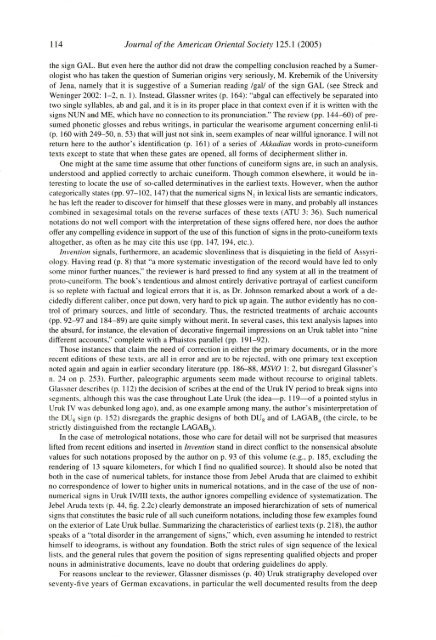PDF copy - CDLI
PDF copy - CDLI
PDF copy - CDLI
Create successful ePaper yourself
Turn your PDF publications into a flip-book with our unique Google optimized e-Paper software.
114 Journal of the American Oriental Society 125.1 (2005)<br />
the sign GAL. But even here the author did not draw the compelling conclusion reached by a Sumerologist<br />
who has taken the question of Sumerian origins very seriously, M. Krebernik of the University<br />
of Jena, namely that it is suggestive of a Sumerian reading /gal/ of the sign GAL (see Streck and<br />
Weninger 2002: 1-2, n. I). Instead, Glassner writes (p. 164): "abgal can effectively be separated into<br />
two single syllables, ab and gal , and it is in its proper place in that context even if it is written with the<br />
signs NUN aad ME, which have no connection to its pronunciation." The review (pp. l44-60) of presumed<br />
phonetic glosses and rebus writings, in particular the wearisome argument concerning enlil-ti<br />
(p. l60 with 249-50, n. 53) that will just not sink in, seem examples of near willful ignorance. I will not<br />
return here to the author's identification (p. l6l) of a series of Akkadian words in proto-cuneiform<br />
texts except to state that when these gates are opened, all forms of decipherment slither in.<br />
One might at the same time assume that other functions of cuneiform signs are, in such an analysis,<br />
understood and applied correctly to archaic cuneiform. Though common elsewhere, it would be interesting<br />
to locate the use of so-called determinatives in the earliest texts. However, when the author<br />
categorically states (pp. 97-102, 147) that the numerical signs NI in lexical lists are semantic indicators,<br />
he has left the reader to discover for himself that these glosses were in many, and probably all instances<br />
combined in sexagesimal totals on the reverse surfaces of these texts (ATU 3: 36). Such numerical<br />
notations do not well comport with the interpretation of these signs offered here, nor does the author<br />
offer any compelling evidence in support of the use of this function of signs in the proto-cuneiform texts<br />
altogether, as often as he may cite this use (pp. l47, 194, etc.).<br />
In vention signals, furthermore, an academic slovenliness that is disquieting in the field of Assyriology.<br />
Having read (p. 8) that "a more systematic investigation of the record would have led to only<br />
some minor further nuances," the reviewer is hard pressed to find any system at all in the treatment of<br />
proto-cuneiform. The book's tendentious and almost entirely derivative portrayal of earliest cuneiform<br />
is so replete with factual and logical errors that it is, as Dr. Johnson remarked about a work of a decidedly<br />
different caliber, once put down, very hard to pick up again. The author evidently has no control<br />
of primary sources, and little of secondary. Thus, the restricted treatments of archaic accounts<br />
(pp. 92-97 and l84-89) are quite simply without merit. In several cases, this text analysis lapses into<br />
the absurd, for instance, the elevation of decorative fingernail impressions on an Uruk tablet into "nine<br />
different accounts," complete with a Phaistos parallel (pp. 191-92).<br />
Those instances that claim the need of correction in either the primary documents, or in the more<br />
recent editions of these texts, are all in error and are to be rejected, with one primary text exception<br />
noted again and again in earlier secondary literature (pp. 186-88, MSVO I: 2, but disregard Glassner's<br />
n. 24 on p. 253). Further, paleographic arguments seem made without recourse to original tablets.<br />
Glassner describes (p. 112) the decision of scribes at the end of the Uruk IV period to break signs into<br />
segments. although this was the case throughout Late Uruk (the idea-po 119-of a pointed stylus in<br />
Uruk IV was debunked long ago), and, as one example among many, the author's misinterpretation of<br />
the DUs sign (p. 152) disregards the. graphic designs of both DUs and of LAGAB a (the circle, to be<br />
strictly distinguished from the rectangle LAGAB b).<br />
In the case of metrological notations, those who care for detail will not be surprised that measures<br />
lifted from recent editions and inserted in Invention stand in direct conflict to the nonsensical absolute<br />
values for such notations proposed by the author on p. 93 of this volume (e.g., p. 185, excluding the<br />
rendering of 13 square kilometers, for which I find no qualified source). It should also be noted that<br />
both in the case of numerical tablets, for instance those from Jebel Aruda that are claimed to exhibit<br />
no correspondence of lower to higher units in numerical notations, and in the case of the use of nonnumerical<br />
signs in Uruk IV/III texts, the author ignores compelling evidence of systematization. The<br />
Jebel Aruda texts (p. 44, fig. 2.2c) clearly demonstrate an imposed hierarchization of sets of numerical<br />
signs that constitutes the basic rule of all such cuneiform notations, including those few examples found<br />
on the exterior of Late Uruk bullae. Summarizing the characteristics of earliest texts (p. 218), the author<br />
speaks of a "total disorder in the arrangement of signs," which, even assuming he intended to restrict<br />
himself to ideograms, is without any foundation. Both the strict rules of sign sequence of the lexical<br />
li sts, and the general rules that govern the position of signs representing qualified objects and proper<br />
nouns in administrative documents, leave no doubt that ordering guidelines do apply.<br />
For reasons unclear to the reviewer, Glassner dismisses (p. 40) Uruk stratigraphy developed over<br />
seventy-five years of German excavations, in particular the well documented results from the deep
















